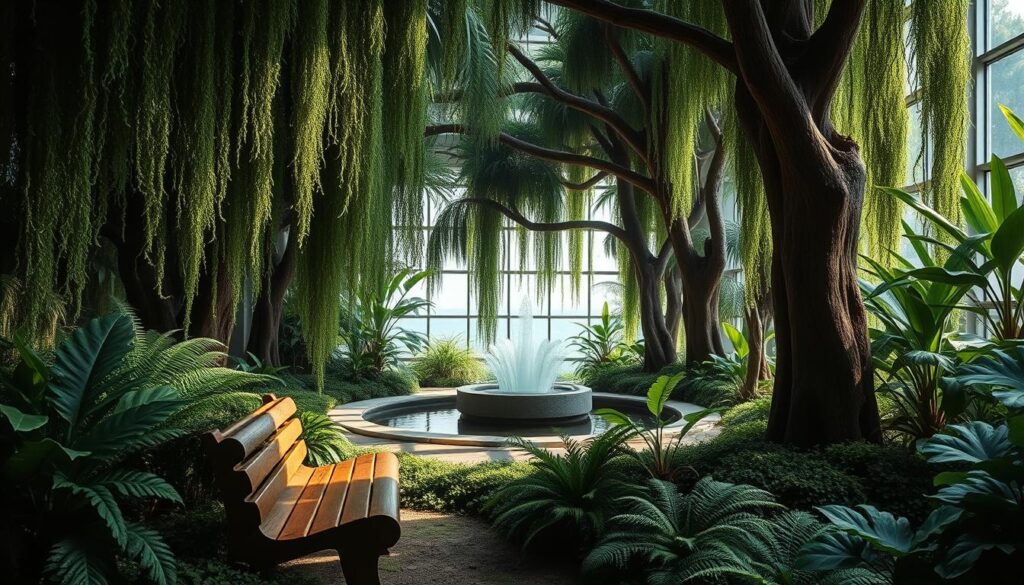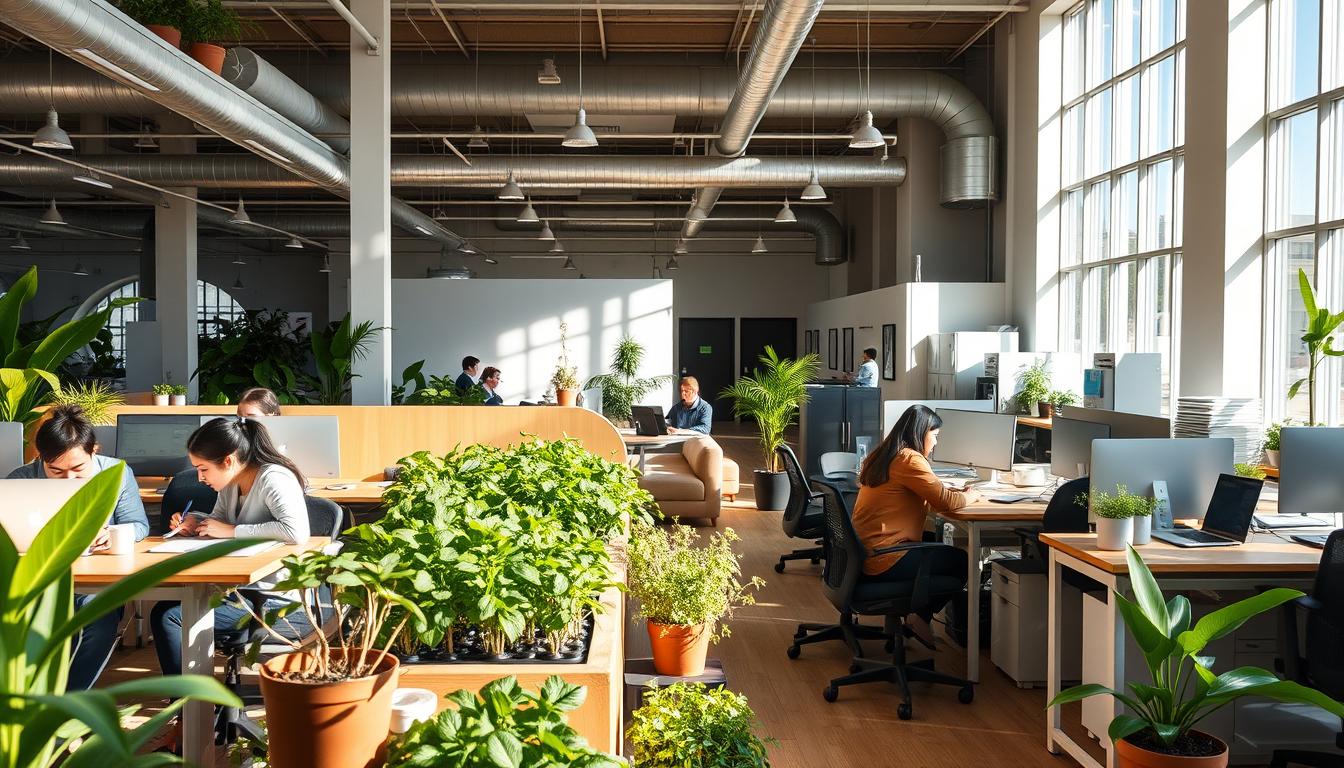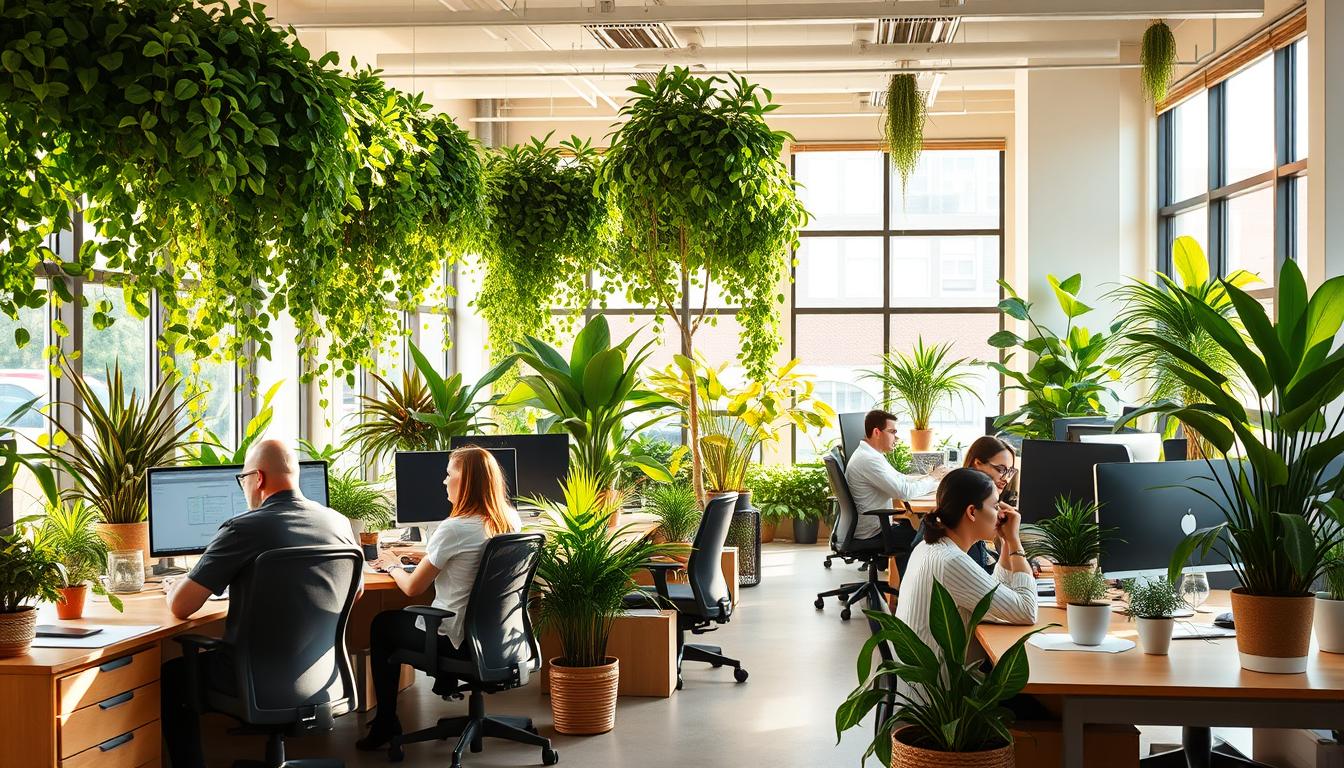In today’s world, work is fast-paced. Creating a biophilic atmosphere is key for better focus and more work done. By using designs inspired by nature, companies can make their workplaces feel like sanctuaries. This improves how people feel and work.
This piece will explain biophilic design. It will show how such environments boost employee performance and happiness. We’ll look at how nature and productivity mix, making workspaces more pleasant.
Understanding Biophilic Design
Biophilic design mixes nature with our living spaces. This idea is rooted in our deep link to nature. It’s especially useful in work areas. By knowing what it is and why it matters, we see how it makes work life better.
Definition of Biophilic Design
This design includes many ways to bring nature into places where we live and work. It’s more than just looking nice; it’s about feeling good. By adding elements like light, plants, and natural materials, we create spaces that make us happier and more at peace.
The Importance of Nature in Human Life
Nature is crucial for our health, both mental and physical. Highlighting our bond with nature helps fight stress and worry, especially in busy jobs. Using biophilic design can improve how we feel. This boosts how well we do our jobs. Workplaces that embrace nature help their teams feel better and do better.

The Science Behind a Biophilic Atmosphere
Looking into how nature affects our well-being is both interesting and insightful. Research shows that nature has a big impact on our bodies and minds, especially in workspaces meant for creativity.
Psychological Benefits of Nature
Being around nature can make you feel happier and think clearer. People who spend time in green spaces tend to have less stress and focus better. Nature has a soothing effect, helping us be more creative and attentive.
Physiological Impacts of Natural Elements
Adding nature to where you work has great health benefits. Sunshine and plants can lower your stress by decreasing cortisol levels. This makes us feel better overall. Having natural elements around us also makes our physical health better, protecting us from the harms of stressful work environments.
Elements of a Biophilic Atmosphere for Deep Focus
Creating a biophilic atmosphere means designing workspaces that connect people to nature. This includes using natural light, adding materials like wood, and putting plants around. These steps help focus, improve mood, and increase productivity. By doing this, we create a space that makes it easier to pay attention and dive into work.
Incorporating Natural Light
Natural light is key to better workspace design. It makes us less dependent on fake light, which can tire us out. Having more natural light boosts our mood and keeps us alert. It makes for a lively space. Getting sunlight helps keep our body clock in check, raising productivity all day.
Utilizing Natural Materials
Using natural materials like wood and stone makes a space look better and feel accessible. These elements bring warmth and a hint of nature inside. This makes the place more relaxing. By adding natural textures, the workspace becomes cozier, sparking creativity and teamwork.
Integrating Greenery and Plant Life
Adding plants to the design helps in lots of ways, from cleaning the air to lowering stress. Plants are like natural air purifiers, taking away bad toxins and brightening the space. Having plants around makes things calmer, helping us focus. When we add plants correctly, we craft a dynamic and healthy workspace.
Benefits of a Biophilic Atmosphere
Creating a biophilic atmosphere brings huge advantages. It betters personal and collective experiences. Organizations that adopt this design see big changes in their spaces. Studies link biophilic design with better mental and physical health.
Reduced Stress Levels
At its heart, biophilic design helps lower stress. Natural elements like plants and water features make a place calming. Research shows that biophilic spaces can reduce stress hormones, easing anxiety and lifting spirits.
Enhanced Cognitive Functions
Biophilic design also boosts brain power. It’s proven to help with memory and focus. Workers in these spaces are sharper and more productive. This boosts a company’s success by unlocking the full potential of its employees.
Promotion of Overall Well-being
A biophilic setting supports well-being all around. It makes workplaces healthier and more welcoming, sparking creativity and teamwork. Happy, less stressed employees are more involved, improving workplace culture vastly.
How to Create a Biophilic Atmosphere for Deep Focus
Creating a biophilic atmosphere boosts productivity and well-being at work. Adding natural elements into your design can really improve focus and creativity. By focusing on practical tips and working with experts, you can make your workspace more peaceful.
Practical Tips for Implementation
First, take a good look at your space to see what you can change. Think about these steps:
- Check where natural light comes in and place work areas there.
- Use materials like wood and stone to make the area feel warm.
- Pick colors that remind you of nature to boost mood and energy.
- Add plants, living walls, or indoor gardens to bring in greenery.
It’s important to ask employees what they think. Knowing what nature-inspired elements they like helps ensure the space boosts their well-being.
Collaborating with Experts
Working with experts can give you designs that really match your workplace’s vibe. Designers and architects bring valuable insights and new ideas. Why it’s great to team up:
- They can create designs just for your space.
- You get to know the latest biophilic design trends and research.
- They bring expertise that can make the project go smoothly.
Maximizing Sensory Experiences in Design
Creating a biophilic atmosphere means paying close attention to what we see and hear. Bringing together visual design and soundscapes helps make places where people can concentrate better, be more creative, and work well.
Visual and Aesthetic Considerations
Visual design is key to our sensory experiences. Using art that mirrors nature, organic shapes, and lots of natural light makes spaces calm and welcoming. Choosing colors that remind us of nature also makes us feel closer to the outside, boosts our mood, and helps us get more done.
Soundscapes that Enhance Focus
Soundscapes are really important for keeping us focused. Adding natural sounds like water flowing or birds singing helps create a soothing background. This helps block out distracting sounds so we can stick to our tasks. By mixing these elements into our workspaces, we boost our senses. This fits right with biophilic design, making us feel better overall.
Strategic Use of Space and Layout
A smart layout makes a biophilic environment work better. It helps or hinders how much gets done. Placing quiet zones and team areas properly lets people focus and work together well. This balance makes the office more efficient and more enjoyable.
Good design helps people move through spaces easily. Paths with curves and open areas feel more natural. This makes places easier to get around and nicer to be in. Focusing on how space is arranged makes the workplace better. It boosts productivity and makes everyone happier.
Incorporating Water Features
Water features are key to improving the look and feel of workspaces. They add beauty and bring the soothing sounds of water. This can make employees happier and more productive. By adding nature-inspired elements, workplaces become places where focus and creativity bloom.
The Calming Effects of Water in Workspaces
Research shows water features make workplaces less stressful. The sound of water helps people relax by blocking out noise. Workers feel calmer, happier, and more satisfied with their jobs. Water also boosts creativity and encourages people to work together better.
Practical Examples of Water Features
There are many ways to add water features to a workspace. Some ideas include:
- Indoor fountains that are both beautiful and soothing.
- Wall-mounted water displays that improve air and look great.
- Aquariums that catch the eye and soothe the mind.
- Reflecting pools outside for peaceful breaks.
Implementing Seasonal Changes in the Decor
Adding seasonal elements to your workspace can make it more lively and engaging. It helps connect the indoor vibe with the outside world. Doing this can enhance the beauty and mood of your office, making every season enjoyable during work.
Adapting to Natural Rhythms
Matching your workspace decor with the seasons takes a more complete approach to design. It makes your office reflect the changes happening in nature. This lets employees feel a deeper bond with their surroundings. Here are some ideas:
- Integrate warm hues of autumn leaves during fall.
- Use pastel colors and floral patterns to welcome spring.
- Add winter-themed elements like cool blues and whites.
- Incorporate vibrant summer colors that evoke bright sunlight.
Creating Dynamic Visual Interests
Keeping decor dynamic makes your workspace more appealing. By using different colors and textures with the seasons, the place stays fresh. Here are a few ways to do this:
- Rotating artwork that celebrates seasonal landscapes.
- Incorporating seasonal plants that resonate with natural rhythms.
- Switching out textiles such as cushions or curtains for seasonal themes.
These updates boost the energy of your workplace. They also help build strong emotional ties among staff. This creates a feeling of togetherness and happiness in their work environment.
Measuring the Impact of Biophilic Design
To know if biophilic design works well, companies need a clear plan. They can learn a lot by asking employees what they think. This feedback shows the effect of nature-like elements on work and happiness at the job.
Feedback from Employees
It’s crucial to hear what employees have to say. Surveys and interviews can reveal how people feel about their workspaces. Here are the main things to find out:
- How happy people are with the look of their work area
- If they feel better and more focused
- What changes they want
Assessing Productivity and Engagement
Understanding the real effect requires looking at numbers too. Checking attendance, how well employees do their jobs, and their involvement helps. This way, companies can see the real benefits of adding nature to workspaces. Regular checks lead to:
- Seeing how changes affect work output
- Comparing interest in work before and after updates
- Better plans for improving the office
Conclusion
When offices include biophilic design, everyone wins. Workers get more focused and feel better. It’s more than just making a place look nice. Adding nature to workspaces cuts stress and makes our brains work better. This creates a peaceful place to work.
Biophilic design shows a deep care for improving work life. It teaches us that nature is key to our daily routines. By adding natural touches, businesses help their teams and the planet. They show they care about being green and healthy.
Moving towards a nature-filled office is a step-by-step journey. But the outcomes are huge for businesses that stick with it. It means changing workplaces for the better, for a long time.



